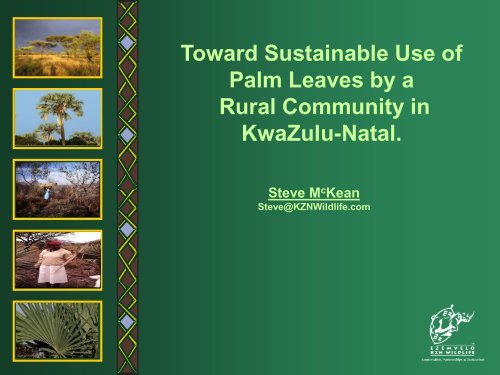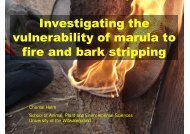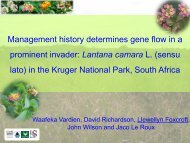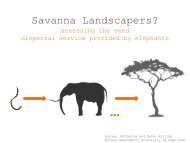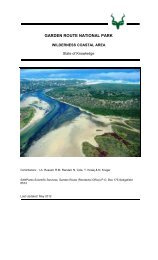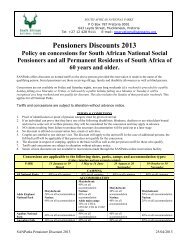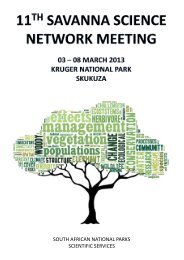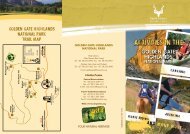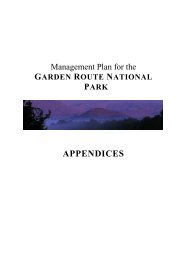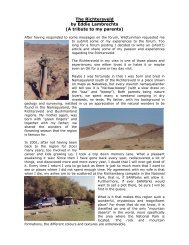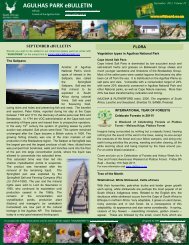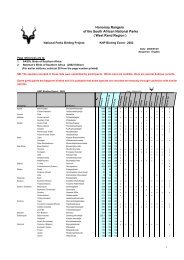Toward Sustainable Use of Palm Leaves by a Rural ... - SANParks
Toward Sustainable Use of Palm Leaves by a Rural ... - SANParks
Toward Sustainable Use of Palm Leaves by a Rural ... - SANParks
Create successful ePaper yourself
Turn your PDF publications into a flip-book with our unique Google optimized e-Paper software.
<strong>Toward</strong> <strong>Sustainable</strong> <strong>Use</strong> <strong>of</strong><br />
<strong>Palm</strong> <strong>Leaves</strong> <strong>by</strong> a<br />
<strong>Rural</strong> Community in<br />
KwaZulu-Natal.<br />
Steve M c Kean<br />
Steve@KZNWildlife.com
Presentation Structure<br />
• Introduction and background<br />
• Aims and methods<br />
• Results<br />
• Conclusions and recommendations
Hyphaene coriaceae<br />
iLala palm<br />
- Up to 9m high but mainly short stemmed cluster.<br />
- Dioecious. Up to 2000 fruits per branch on female plants.<br />
- Produces 2 - 5 new leaves per stem annually throughout year.<br />
- Occurs on nutrient poor sandy soils.
<strong>Use</strong>s<br />
- Leaf harvest … craftwork (commercial and subsistence). Unopened<br />
leaves 80cm or longer preferred. Valued for strength and fibre length.<br />
- Sap tapping for palm wine making.<br />
- Edible fruit.
Value<br />
- Vital part <strong>of</strong> local economy in Maputaland although economic<br />
contribution <strong>of</strong> leaf harvest not researched.<br />
- Mainly harvest and sale <strong>of</strong> raw leaves <strong>by</strong> women with little “value<br />
adding” done in area.<br />
- Subsistence but buffer against poverty.
Management issues<br />
- Harvest request from protected area.<br />
- No clear resource rights or tenure – “open access” and consequent<br />
over-exploitation <strong>of</strong> iLala outside. Clash with sap tappers.<br />
- Unique opportunity to initiate a co-operative project on sustained use <strong>of</strong><br />
a much needed resource with local people.
Research questions<br />
- What effect do different leaf harvest intensities have<br />
on numbers <strong>of</strong> leaves produced?<br />
- Do different harvest intensities influence the number<br />
<strong>of</strong> usable leaves produced?<br />
- What is the most suitable harvest intensity to ensure<br />
long term sustainable use <strong>of</strong> the resource and<br />
simultaneously attempt to satisfy demand?
Study Area
Methods<br />
- Experiment designed in cooperation with harvesters.<br />
- Strategies agreed for control <strong>of</strong> illegal use. No sap<br />
tapping.<br />
- Harvesters given sole rights to harvest leaves from study<br />
area.<br />
- Shared law enforcement responsibility with conservation<br />
.<br />
agency.<br />
- Harvesters cut leaves at the agreed experimental rates.
Data collection<br />
- <strong>Leaves</strong> were cut annually during May for four years. At each marked<br />
palm, within each treatment, the following data were collected before<br />
any leaves were cut, and subsequently at four monthly intervals:<br />
- The number <strong>of</strong> unopened leaves and partially emerged leaf<br />
blades.<br />
- Leaf blade length and length <strong>of</strong> partially emerged leaf<br />
blades.<br />
- 3 experimental treatments, i.e. control (no leaves cut), one leaf cut<br />
per year and all leaves cut per year. Three replicates <strong>of</strong> each<br />
treatment, each containing ten palms were randomly located in the<br />
study area and marked with tags.<br />
-Stem density analysis for area.
Results
Usable leaves per stem (mean)<br />
Effect <strong>of</strong> harvest intensity on leaf<br />
production<br />
• No significant effect <strong>of</strong> harvest intensity on leaf production.<br />
• Some indication <strong>of</strong> decline in leaf production at high and no leaf<br />
harvest.<br />
2.5<br />
0 - control 1 - 1 cut 3 - all cut<br />
2<br />
1.5<br />
1<br />
0.5<br />
0<br />
Nov<br />
'92<br />
June '93Dec '93 June '94Dec '94 June '95 Dec '95 June '96 Dec '96<br />
0 1 3 0 1 3 0 1 3 0 1 3 0 1 3 0 1 3 0 1 3 0 1 3 0 1 3<br />
Number <strong>of</strong> leaves cut per stem
Mean leaf length (m)<br />
Effect <strong>of</strong> harvest intensity on leaf growth<br />
• Effect <strong>of</strong> harvest intensity on mean leaf length not significant.<br />
1.2<br />
0 - control 1 - 1 cut 3 - all cut<br />
1<br />
0.8<br />
0.6<br />
0.4<br />
0.2<br />
Dec<br />
'92<br />
June' '93 Dec '93 June '94 Dec '94 June '95 Dec '95 June '96 Dec '96<br />
0<br />
0 1 3 0 1 3 0 1 3 0 1 3 0 1 3 0 1 3 0 1 3 0 1 3 0 1 3<br />
Number <strong>of</strong> leaves cut per stem
“Standing stock” <strong>of</strong> iLala in harvest area.<br />
• Total density - 865 stems per hectare.<br />
• Of these, 295 stems per hectare (SD = 160), or 34% <strong>of</strong> the total,<br />
produce leaves <strong>of</strong> usable size.
Conclusions<br />
• Results, combined with density estimates, an annual<br />
leaf production <strong>of</strong> approximately three leaves per stem<br />
and a precautionary approach, lead to an initial harvest<br />
intensity recommendation <strong>of</strong> one leaf per stem per year.<br />
• This represents 34 % <strong>of</strong> annual leaf production available<br />
for harvest.
- Responsibility <strong>of</strong> EKZN Wildlife to ensure the sustainable<br />
use <strong>of</strong> resources from Ozabeni.<br />
- Difficult, if not impossible, to monitor the number <strong>of</strong><br />
leaves being harvested from an area <strong>of</strong> 650 ha.<br />
- During the harvest process, leaves are cut <strong>by</strong> local<br />
women and tied into bundles <strong>of</strong> approximately 40. The<br />
number <strong>of</strong> bundles harvested is possible to monitor.<br />
- Approximately 19.6% <strong>of</strong> annual production was<br />
harvested annually from the study area <strong>by</strong> 46 women -<br />
well within researched ecological limits.
But its not quite as simple as that …….<br />
- Ecological problems with attempting to maintain constant harvest<br />
levels <strong>of</strong> species.<br />
- iLala harvest is most likely to be sustainable when resource<br />
management methods acceptable to both the users and managers<br />
are implemented. These methods need to address the issues <strong>of</strong><br />
access rights and responsibility, economic benefit to the users and<br />
impact <strong>of</strong> harvest on the resource and the system in which it is<br />
found.
Recommendations<br />
- Develop a long term adaptive management strategy with users.<br />
- Baseline <strong>of</strong> 1 leaf per stem per year harvest but vary over space,<br />
time and build in ecological variability.<br />
- Take changes in socio-economic and ecological factors into account<br />
and use monitoring information to revise management <strong>of</strong> the<br />
resource when necessary.<br />
- Monitor number <strong>of</strong> leaves harvested <strong>by</strong> counting bundles harvested.
Reference<br />
M c Kean, S. G. (2003) <strong>Toward</strong> sustainable use <strong>of</strong> palm<br />
leaves in a South African protected area. Economic<br />
Botany 57 (1).


